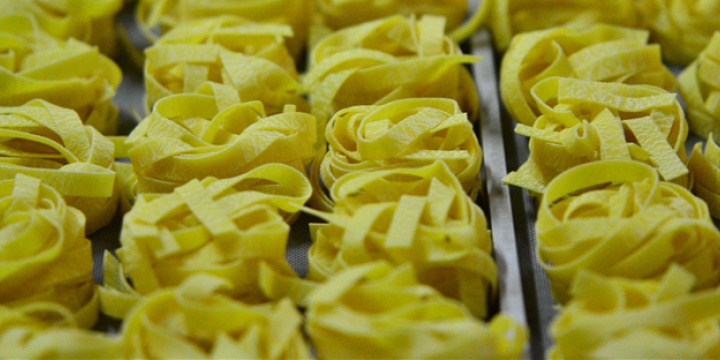
Once the dough has been formed, the next process is extrusion.
Dies are the accessories used to shape the water and semolina dough and
are used to create the many pasta shapes available on the market. They
are also highly technological, as in addition to shaping the pasta they
also affect the characteristics of the pasta obtained, the thickness of
each shape and the development and consistency of the gluten, the most
important protein contained in durum wheat semolina. Its presence is
fundamental for ensuring that, once cooked, the pasta has that
elasticity and toughness, a sensation commonly defined as al dente
(Italian term meaning firm to the bite).
Every single pasta shape has its own specific die, which in Granoro is
made to Attilio’s design, so each shape, based on its size, form and the
type of durum wheat semolina used, will have the most suitable
thickness for the right and most appropriate cooking time.
Granoro pasta is produced using both Teflon and bronze dies: the type
used depends on the characteristics that need to be enhanced for each
shape, such as the colour, uniformity, porosity and roughness.
Granoro produces more than 150 different shapes of high-quality pasta in
a number of ranges: standard pasta shapes, special semolina pasta,
special egg pasta, special spinach pasta, special pasta from the Attilio
range, special burnt wheat pasta and special pasta from the wellness
range composed of organic, organic whole wheat and Cuore Mio pasta (the
latter produced from durum wheat semolina and barley flour). Last but
certainly not least is the Dedicato range, symbol of a production range
of the highest quality produced exclusively in Puglia, certified and
traceable from the field to the table, the result of a food supply chain
agreement between Granoro, the farmers and the mill that transforms the
durum wheat into semolina.
It is of fundamental importance for Granoro that shapes are produced with the “right” thickness.
The dies used to produce the various pasta shapes after the dough has
been kneaded are made to specific Granoro designs: the thickness is
correct and carefully calculated to ensure the cooking time is not too
long.
Granoro has carefully researched the most suitable thicknesses for each
pasta shape based on the desired diameters, shapes and cooking times.
Pasta factories often produce the same pasta shapes with different
thicknesses, and therefore different cooking times, for reasons related
to the specific production criteria of each pasta factory.
Granoro could have chosen to produce pasta with greater thicknesses and
longer cooking times, using dies designed to produce shapes with these
characteristics. But Granoro has always chosen to produce the various
pasta shapes with shorter cooking times compared to other pasta
factories, because it believes that when pasta is too thick it stays raw
inside, even after cooking, giving it the impression of being al dente.
It also has the following disadvantages: